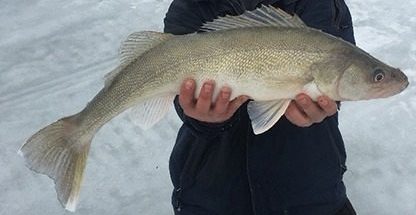Walleye vs Sauger: Can you tell the difference?
A common question we get from new anglers is “Is this a walleye or a sauger?” Although obvious on many occasions, Mother Nature has been known to throw a few tricks into the identification process.

Manitoba Northern Region Golden Walleye. (Wekusko Lake)
Colour Ranges:
Both walleye and saugers call various waterbodies across the province home; and both species can take on different looks and appearances depending on which waterbody they reside. The Northern Region of Manitoba is where the famous “Golden Walleyes” call home. The colours of walleye in the North will often range vastly from a dark olive green to the well-known yellowish gold. The sides of the walleye are often marked with a solid or uniform pattern with a brassy yellow flex in their scales. In many of the prairie lakes in Southern Manitoba, walleye take on a lighter variation of these northern walleyes called the "Prairie Gold Walleye”.

Prairie Gold Walleye. (Lake Manitoba)
Perhaps the most famous colour variation of Manitoba walleyes, is the emerald green shimmer of the ones found in the legendary Lake Winnipeg, known as "Greenback Walleyes". The sides of these greenbacks take on a much whiter and almost silver appearance compared to their golden-coloured, northern counterparts.

Greenback Walleye (Lake Winnipeg)
Like the walleye, saugers will also take on a darker, almost golden appearance (for the most part), in the northern reaches of their Manitoba range. Also, in the north, the saugers defining features are generally much more defined and easier to distinguish. Conversely, saugers will appear much lighter in the southern lakes and river systems and in many situations, it takes a keen eye to pick out their defining characteristics.

Assiniboine River Sauger

Lake Manitoba Sauger

Little Saskatchewan River Sauger

Wekusko Lake Sauger
Defining Characteristics
So now we know both of these species have great variation in colour ranges depending on which body of water they call home. And each of these species’ defining characteristics vary in prominence depending on where they are. Sounds confusing right? First, lets get into these distinguishing features and shed some light on this confusion.
Dorsal Fin:
Both walleye and saugers have a translucent dorsal fin. These fins can often be easily distinguished apart. On a walleye, they will have dark splotch found in the rear spines of their dorsal. For a sauger there will be an absence of this splotch and instead they are set apart by black spots speckled across the fin.

Greenback Dorsal. (Note the black on rear spines)

Sauger Dorsal. (Note the black spots/blotches throughout)
Tail Fin:
These two species can also differ by their tail fin. On the walleye’s lower portion of the bottom tail fin, you will find a white patch that spans to the tip of the fin. Saugers do not have this marking on their tail fin and instead keep a consistent pattern, similar to that of their dorsal throughout.

Walleye Tail (Note the white patch on tip of tail)

Sauger Tail (Note the consistent pattern throughout)
Body:
As mentioned earlier, walleye can often change drastically in colour depending on the waterbody. However, no matter which colour variation of walleye. The colour of the body will be a solid or uniform pattern throughout. This differs from a sauger as they will generally have a less consistent pattern with dark blotches or spots appearing across their sides.

Walleye (Note the consistent, uniform pattern on the body)

Sauger (Note the black blotches on the body)
Size:
One of the most obvious differences between a walleye and a sauger is that walleye grow larger than the average sauger. A mature sauger will be much smaller and have a slenderer appearance than a mature walleye.

Mature 32" Lake Of the Prairies "prairie gold walleye"

Mature Assiniboine River Sauger
Fun Fact:
The name of the walleye stems from their pearlescent eyes which help them to see and feed with ease in both the dark and in turbid water conditions. However, saugers can see even better than walleyes in the same conditions. This could be a reason why in many situations on the Red River, you can catch so many saugers when the walleyes do not seem to be biting.

Sasaginnigak Lake 32" "Golden Walleye."
Just that Easy… Right?
With all that being said, in my experience there is still many instances where some of these defining characteristics are not prominent enough to definitively set them apart. Sometimes the white splotch on a walleyes tail isn’t super prominent. Other times times the spots on the dorsal or the blotches on the sides of a sauger aren’t well defined. At times a small walleye and a small sauger on Lake Winnipeg, the Red River or the Assiniboine River can appear nearly identical.
Confusing right?...There are situations that just one of these characteristics above does not solve this debate. However, combining all these characteristics into a metaphorical checklist in your head, will, in most cases yield a definitive answer to the walleye or sauger dilemma. That is unless of course the fish you have caught is the hybrid saugeye… but that’s a conversation for another day.

HuntFishMB – Keevin Erickson
For more information on sauger vs walleye identification check out this Manitoba Wildlife Federation video.
Visit the HuntFishMB Blog page for content you can enjoy within the comforts of home.
*Protect Manitoba’s water and resources. Stop aquatic invasive species. For more information on how to do your part visit the Sustainable Development AIS page.

